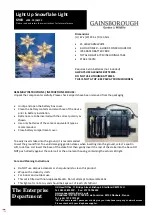
5.2
Calculating Minimum Required Fall Clearance
5.2.1
DuraTech LE (All Sizes) in Overhead, Non-Leading Edge Anchorage Application
The DuraTech LE may be used may be used as a standard SRD in an overhead
condition, in which the SRD is installed anywhere in the allowable attachment
area, which ranges from directly above the user to level with the FBH D-ring, as
shown in Figure 4.
The overhead condition minimum required fall clearance (MRFC) is
calculated using four metrics, measured from the walking-working surface:
SRD Deceleration Distance, D-Ring Shift and Harness Stretch [1 ft (0.3m)],
Safety Factor [1.5 ft (0.5m)], and Swing Fall. Chart 1 below is calculated using
the performance data of the SRD and includes all four metrics listed previously
to determine the MRFC.
X
-Set -Back
Distanc
e
Y
-Lateral O
ffset Dist
.
Z
- Minimum Required
Fall Clearance From
Working Surface
20.5
28.0
X
-SRD Anchorage Height
Above Dorsal D-ring
Z
- Minimum Required
Fall Clearance From
Working Surface
Y
- Lateral
Offset Distance
Figure 4 - MRFC Overhead Anchorage
0 ft
(0 m)
2 ft
(0.7 m)
4 ft
(1.3 m)
6 ft
(1.9 m)
8 ft
(2.5 m)
10 ft
(3.1 m)
12 ft
(3.7 m)
14 ft
(4.3 m)
16 ft
(4.9 m)
18 ft
(5.5 m)
20 ft
(6.1 m)
22 ft
(6.8 m)
24 ft
(7.4 m)
60 ft
(18.3 m)
6.0
(1.9)
6.5
(1.9)
6.5
(1.9)
6.5
(1.9)
7.0
(2.1)
7.0
(2.1)
7.5
(2.3)
8.0
(2.5)
8.5
(2.6)
9.0
(2.7)
9.5
(2.9)
10.0
(3.1)
11.0
(3.3)
55 ft
(16.8 m)
6.0
(1.9)
6.5
(1.9)
6.5
(1.9)
6.5
(1.9)
7.0
(2.1)
7.0
(2.1)
7.5
(2.3)
8.0
(2.5)
8.5
(2.6)
9.0
(2.7)
10.0
(3.1)
10.5
(3.2)
11.5
(3.5)
50 ft
(15.3 m)
6.0
(1.9)
6.5
(1.9)
6.5
(1.9)
6.5
(2.0)
7.0
(2.1)
7.0
(2.2)
7.5
(2.3)
8.0
(2.5)
8.5
(2.6)
9.5
(2.8)
10.0
(3.1)
11.0
(3.3)
11.5
(3.5)
45 ft
(13.8 m)
6.0
(1.9)
6.5
(1.9)
6.5
(1.9)
6.5
(2.0)
7.0
(2.1)
7.5
(2.2)
8.0
(2.4)
8.5
(2.5)
9.0
(2.7)
9.5
(2.9)
10.5
(3.2)
11.5
(3.4)
12.0
(3.7)
40 ft
(12.2 m)
6.0
(1.9)
6.5
(1.9)
6.5
(1.9)
6.5
(2.0)
7.0
(2.1)
7.5
(2.3)
8.0
(2.4)
8.5
(2.6)
9.5
(2.8)
10.0
(3.1)
11.0
(3.3)
12.0
(3.6)
13.0
(3.9)
35 ft
(10.7 m)
6.0
(1.9)
6.5
(1.9)
6.5
(1.9)
7.0
(2.0)
7.0
(2.2)
7.5
(2.3)
8.0
(2.5)
9.0
(2.7)
9.5
(2.9)
10.5
(3.2)
11.5
(3.5)
12.5
(3.8)
13.5
(4.1)
30 ft
(9.2 m)
6.0
(1.9)
6.5
(1.9)
6.5
(2.0)
7.0
(2.1)
7.5
(2.2)
8.0
(2.4)
8.5
(2.6)
9.5
(2.8)
10.0
(3.1)
11.0
(3.4)
12.5
(3.7)
13.5
(4.1)
14.5
(4.4)
25 ft
(7.7 m)
6.0
(1.9)
6.5
(1.9)
6.5
(2.0)
7.0
(2.1)
7.5
(2.3)
8.0
(2.5)
9.0
(2.7)
10.0
(3.0)
11.0
(3.3)
12.0
(3.6)
13.5
(4.0)
14.5
(4.4)
16.0
(4.8)
20 ft
(6.1 m)
6.0
(1.9)
6.5
(1.9)
6.5
(2.0)
7.0
(2.1)
8.0
(2.3)
8.5
(2.6)
9.5
(2.9)
10.5
(3.2)
12.0
(3.6)
13.0
(4.0)
14.5
(4.4)
16.0
(4.8)
17.5
(5.3)
15 ft
(4.6 m)
6.0
(1.9)
6.5
(1.9)
7.0
(2.0)
7.5
(2.2)
8.0
(2.5)
9.5
(2.9)
10.5
(3.2)
12.0
(3.6)
13.0
(4.0)
14.5
(4.4)
16.0
(4.9)
18.0
(5.4)
19.5
(5.9)
10 ft
(3.1 m)
6.0
(1.9)
6.5
(1.9)
7.0
(2.1)
8.0
(2.4)
9.0
(2.7)
10.5
(3.1)
12.0
(3.6)
13.5
(4.1)
15.0
(4.6)
17.0
(5.1)
18.5
(5.6)
20.5
(6.2)
22.0
(6.8)
5 ft
(1.6 m)
6.0
(1.9)
6.5
(1.9)
7.5
(2.3)
9.0
(2.7)
10.5
(3.1)
12.5
(3.6)
14.0
(4.1)
16.0
(4.6)
18.0
(5.5)
20.0
(6.0)
22.0
(6.6)
24.0
(7.2)
26.0
(7.8)
0 ft
(0 m)
6.0
(1.9)
8.0
(2.5)
10.0
(3.1)
12.0
(3.7)
14.0
(4.3)
16.0
(4.9)
18.0
(5.5)
20.0
(6.1)
22.0
(6.8)
24.0
(7.4)
26.0
(8.0)
28.0
(8.6)
30.0
(9.2)
SRD Anchor
ag
e Heigh
t Abo
ve Dor
sal D-Ring (X)
Lateral Offset Distance (Y)
Chart 1
Overhead
Using Chart 1 to Calculate Minimum Required Fall Clearance for the DuraTech LE
2 foot (0.6 m) increments along the Y-Axis represent the
Lateral
Offset Distance
the user is working away from being directly
under the SRD
5 foot (1.5 m) increments up the X-Axis represent the
SRD Anchorage Height
above the user’s Dorsal D-Ring
Example:
If the user needs to work 10 feet (3.1 m) away from directly under the SRD, the SRD needs to be anchored at least 15 feet (4.6 m) above
the user’s Dorsal D-Ring. Minimum required fall clearance is 9.5 feet (2.9 m) at maximum allowable swing fall.
Example:
If the only suitable Anchorage for the SRD is at D-Ring height [0.0 feet (0.0 m)] above the user’s Dorsal D-Ring, the maximum allowable
work zone is 4 feet (1.3 m) away from the SRD. Minimum required fall clearance is 10.0 feet (3.1m) at maximum allowable swing fall.
Key to Work Zone Areas:
= Allowable Use Area = Not Allowed Use Area
WORKING IN THIS AREA MAY RESULT IN SERIOUS INJURY OR DEATH
MSRD28 Rev B
081723
9







































